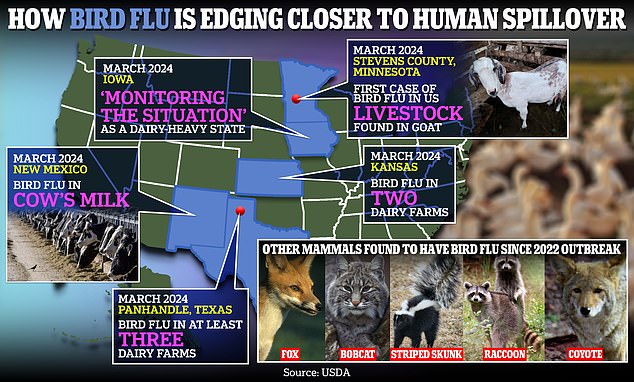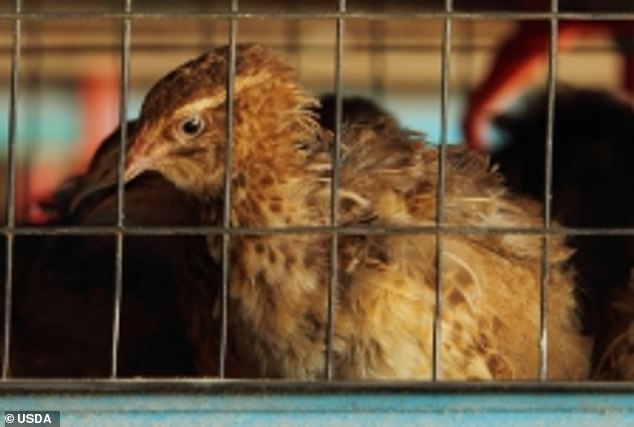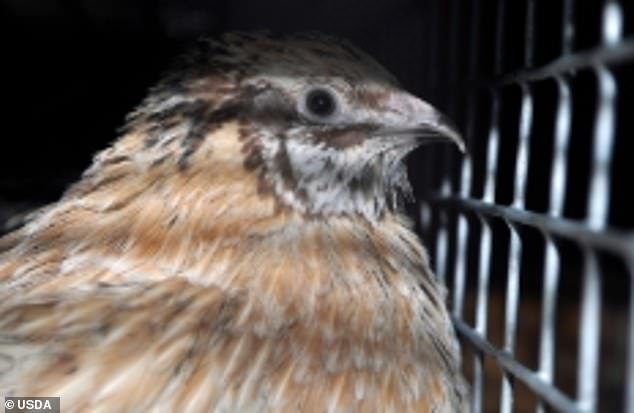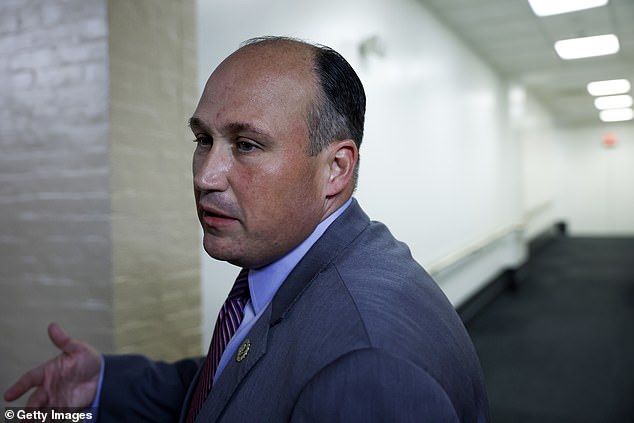USDA and China CCP lab are creating deadly BIRD FLU viruses as part of $1m collaboration – and YOU are paying for it
Lawmakers are demanding answers after it emerged that the US is sending taxpayer money to a Chinese military laboratory to make bird flu viruses more dangerous to humans.
Eighteen members of Congress are demanding answers from the Department of Agriculture (USDA) on the project, which was first revealed by DailyMail.com.
It is part of a $1 million partnership between the USDA and the CCP-led Chinese Academy of Sciences – the institution that oversees the Wuhan laboratory at the center of the Covid lab leak theory.
In a scathing letter to USDA Secretary Tom Vilsack last week, the bipartisan group said, “This research, funded by American taxpayers, could generate potentially dangerous new laboratory-created strains of the virus that threaten our national security and public health.”
The White Coat Waste Project has obtained the above photo and claims it shows animal experiments at the USDA laboratory working with Chinese scientists on bird flu research.

Testing showed that an unknown number of cows have tested positive for Type A H5N1 bird flu in Texas, Kansas and New Mexico. Iowa is currently monitoring the situation as it is also a dairy-producing state. It comes after a goat in Minnesota tested positive last week. Bird flu has also been found in foxes, bobcats, striped skunks, raccoons and coyotes since the 2022 outbreak
The research comes at a time when fears about bird flu are increasing. A farm worker in Texas contracted the H5N1 strain that swept through U.S. livestock earlier this month, becoming only the second American ever to be diagnosed — and experts are preparing for more cases.
Earlier this year it was announced that the US government would funnel $1 million to China to see if scientists could make ‘highly pathogenic bird flu’ more contagious to mammals using gain-of-function research.
Government data shows the partnership began in April 2021 and is expected to be funded through March 2026. The USDA previously told this website that the project was requested in 2019 and approved in 2020.
The research involves infecting ducks and geese with different strains of the virus to make them more contagious, and studying the viruses’ potential to “jump into mammalian hosts,” according to research papers.
It is funded by the U.S. Department of Agriculture and the project’s key collaborators are the USDA Southeast Poultry Research Laboratory, the Chinese Academy of Sciences and the University of Edinburgh’s Roslin Institute, a laboratory partner from Wuhan.
And this is still ongoing, despite similar research being restricted in 2022 and concerns growing that dubious Chinese studies could have caused the Covid pandemic.
Ironically, President Joe Biden’s administration announced yesterday that it will work with 50 countries to identify and respond to infectious diseases, with the aim of preventing a pandemic that the US’s own research could actually cause.
Last week’s letter was led by Representative Nick Langworthy, a New York Republican who serves on the House Agriculture Committee.
It reads: “We are concerned by recent reports of the U.S. Department of Agriculture’s (USDA) collaboration with the Chinese Communist Party (CCP)-affiliated Chinese Academy of Sciences (CAS) on avian flu research.”
The CAS is the parent organization of the WIV and has previously been banned from receiving US government funding for “blatantly violating grant and biosafety policies, refusing to share laboratory notebooks and other data, and otherwise obstructing investigations into the likely role of the laboratory’s risky coronavirus. [gain of function] research into the origins of Covid-19.
“Our colleagues in the House of Representatives and the Senate recognize CAS’s problematic behavior and have called for sanctions against CAS and its subsidiaries, and for reductions in taxpayer funding for all research involving CAS.”
The signatories then requested written answers to seven questions about the research’s potential to increase the transmissibility of avian flu viruses, details about specific experiments being conducted, the biosafety levels of the experiments, what oversight the USDA provides for CAS, and whether the FBI has a safety risk assessment of the collaboration – and if so, what those results were.
Bird flu is of particular concern right now because a farmer in Texas recently contracted the H5N1 strain of the virus. The patient contracted bird flu from an infected cow, marking the first time the strain had been found in cattle.
They are only the second person to contract H5N1 after someone in Colorado contracted the virus in 2022.
While there is no sign of person-to-person spread — a development that could signal the start of a human epidemic — experts say the ease with which the strain jumps between species increases the risk that it evolves to infect humans more easily.
The Centers for Disease Control and Prevention reports a “low” risk to public health.
However, the virus is widespread among wild birds, with sporadic infections in poultry and mammals.
Experts previously told DailyMail.com that H5N1 has the potential to cause another pandemic.
Dr. Aaron Glatt, an infectious disease expert at Mount Sinai, New York, warned: ‘It is absolutely true that H5N1 has the potential to cause a pandemic.
‘People who work with these animals have to be careful.
“The more this virus spreads, the more likely it is that it could become a strain that can mutate and spread from person to person.”
The H5N1 epidemic that spread around the world emerged in 2020 after a bird was infected with both avian flu from domestic poultry and a virus from wild birds.
During the infection, the two viruses met in the same cell and exchanged genes – in a process scientifically called ‘re-assortment’ – to create the new virus, which now had multiple properties that made it better at infecting bird cells.
It quickly spread around the world, with the first cases identified in Europe – before infections were also discovered in Africa, the Middle East and Asia.

The above shows a caged chicken that The White Coat Waste Project claims comes from the USDA laboratory that works with Chinese government scientists on bird flu research.

The above shows a caged chicken that The White Coat Waste Project claims comes from the USDA laboratory that works with Chinese government scientists on bird flu research.
This month’s letter is not the first from lawmakers to the USDA.
After the February investigation, Republican Senator Joni Ernst of Iowa wrote a letter to Sec Vilsack requesting more information about the department’s ongoing funding of the investigation.
The letter read: “I was disturbed to learn from the nonprofit White Coat Waste Project that USDA is supporting experiments with a ‘highly pathogenic avian flu virus’ that poses a ‘risk to both animals and humans.’
Senator Ernst said in a statement to DailyMail.com at the time: ‘The health and safety of Americans is too important to be taken lightly, and Biden’s USDA should have been more understanding before sending taxpayer money to work with to work. [China] about risky bird flu research.
“They should know by now to suspect ‘fowl’ play when it comes to researchers linked to the dangerous Wuhan Lab, and simply switching from bats to birds is raising concerns that they are creating more pathogens with pandemic potential.”
“Here’s my warning: The Biden administration should walk on eggshells until it cuts off every cent going to our adversaries. We cannot allow what happened in Wuhan to happen again.”
The specific viruses that the study will investigate include H5NX, H7N9 and H9N2, WCW reported.

Representative Nicholas Langworthy (R-NY) speaks to reporters as he walks to the House Republican Conference meeting at the US Capitol Building on July 18, 2023
A 2023 study described H5NX viruses as “highly pathogenic” with the ability to cause neurological complications in humans.
The H7N9 strain first infected people and animals in China in March 2013 and the World Health Organization said this is concerning “as most patients have become seriously ill.”
The H9N2 strain has been found in pigeons in China and although it has lower pathogenicity than the other strains, it can still infect humans.
Despite the concerns, a spokesperson for the USDA told this website that it is “common for international researchers to conduct independent research related to the same end goal” and that the research does not qualify as gain-of-function.
